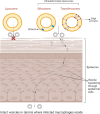Lipid-Based Nanocarriers for Topical Therapy of Cutaneous Leishmaniasis: An Insight into the Mechanism of Action
- PMID: 40547705
- PMCID: PMC12177655
- DOI: 10.1021/acsomega.5c00046
Lipid-Based Nanocarriers for Topical Therapy of Cutaneous Leishmaniasis: An Insight into the Mechanism of Action
Abstract
Cutaneous leishmaniasis (CL) is a parasitic infection caused by Leishmania species, affecting millions worldwide. The current treatment options for CL have several limitations, including low efficacy, inability to reach the target site, potential toxicity, and longer treatment duration, leading to poor patient compliance. Therefore, there is an urgent need for alternative treatments, especially topical ones, that are more effective, safe, and patient-friendly. Although numerous reviews have described the advantages of a wide range of nanoparticles in the treatment of CL, this review narrows its focus to the utilization of novel lipid-based nanocarriers for the topical treatment of CL, offering an in-depth analysis of the topical potential and mechanism of skin permeation of these lipidic nanocarriers. Lipid-based nanostructures such as liposomes, solid lipid nanoparticles, and nanostructured lipid carriers have been extensively studied for CL treatment, either alone or in combination with other drugs or therapies. These carriers can improve the bioavailability, stability, and efficacy of the drug, target the infected site, and reduce adverse effects on healthy tissues. Moreover, these can be easily formulated into different dosage forms, such as creams, gels, or ointments, for convenient topical application. Despite the many benefits of lipid-based carriers, there are still some challenges that need to be addressed, such as optimizing the formulation parameters, ensuring the reproducibility and scalability of the process, and evaluating the long-term safety and efficacy in clinical trials. This study aims to provide a comprehensive overview of the current state-of-the-art lipid-based nanocarriers for topical treatment of CL, covering the recent advances, limitations, clinical evidence, and prospects of this promising approach. In addition, the skin and macrophage targeting potential of various lipid-based nanocarriers is also discussed, which is especially helpful in treating the lesions of CL.
© 2025 The Authors. Published by American Chemical Society.
Figures





Similar articles
-
Interventions for Old World cutaneous leishmaniasis.Cochrane Database Syst Rev. 2017 Dec 1;12(12):CD005067. doi: 10.1002/14651858.CD005067.pub5. Cochrane Database Syst Rev. 2017. PMID: 29192424 Free PMC article.
-
Interventions for Old World cutaneous leishmaniasis.Cochrane Database Syst Rev. 2017 Nov 17;11(11):CD005067. doi: 10.1002/14651858.CD005067.pub4. Cochrane Database Syst Rev. 2017. Update in: Cochrane Database Syst Rev. 2017 Dec 01;12:CD005067. doi: 10.1002/14651858.CD005067.pub5. PMID: 29149474 Free PMC article. Updated.
-
Assessing the comparative effects of interventions in COPD: a tutorial on network meta-analysis for clinicians.Respir Res. 2024 Dec 21;25(1):438. doi: 10.1186/s12931-024-03056-x. Respir Res. 2024. PMID: 39709425 Free PMC article. Review.
-
A rapid and systematic review of the clinical effectiveness and cost-effectiveness of paclitaxel, docetaxel, gemcitabine and vinorelbine in non-small-cell lung cancer.Health Technol Assess. 2001;5(32):1-195. doi: 10.3310/hta5320. Health Technol Assess. 2001. PMID: 12065068
-
Dressings and topical agents for treating pressure ulcers.Cochrane Database Syst Rev. 2017 Jun 22;6(6):CD011947. doi: 10.1002/14651858.CD011947.pub2. Cochrane Database Syst Rev. 2017. PMID: 28639707 Free PMC article.
References
Publication types
LinkOut - more resources
Full Text Sources
